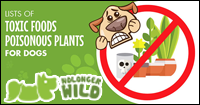 With the holiday season in full swing, it is important to be extra vigilant of the many hazards for our beloved pets.
With the holiday season in full swing, it is important to be extra vigilant of the many hazards for our beloved pets.
This is not an exhaustive list. In a previous post I covered Poisonous Plants for Pets Around Christmas which though not inherently deadly, can cause a lot of problems if they are ingested. Those include Poinsettias, Mistletoe, Holly Lilies, Daffodils, Amaryllis, Christmas Cactus, and Pine Needles. Some are more toxic than others.
An important number to have access to is the ASPCA Animal Poison Control Center hotline at 888-426-4435 as well as your personal vet in case you suspect your pet has digested something toxic.
A few overlooked items prevalent at Christmastime are:
 Tinsel and Ribbons
Tinsel and Ribbons
Young kids especially love playing with ribbons and string. They can often wind up around the neck of your poor patient pooch which does represent a chocking hazard if unsupervised. More likely though, Fido will take the opportunity to taste or even gobble that tinsel which may or may not be spiked with a little Christmas pine sap. If swallowed, ribbons, tinsel and other decorations can cut up the digestive tract and cause intestinal obstruction.
Tree Water
If you have a real Christmas tree, beware of stagnant water in the basis. And stay away from adding chemical additives or tree fertilizer as this can cause vomiting and diarrhea. Even if you use good ole Coca-Cola in your water, a lot of extra stuff like pine needles, ornament clips or even broken shards can wind up mixed with that good tasting water.
 Xlitol
Xlitol
Not all artificial sweeteners are bad for your dog. Saccharin (Sweet ’n’ Low), aspartame (Nutrasweet) and sucralose (Splenda) are generally regarded as safe and should not cause significant illness other than possible osmotic diarrhea.
However Xlitol is especially problematic for dogs who love to munch on sweet things. Cats on the other hand cannot detect the taste of sweetness or are mostly indifferent indifferent about it because they lack a major protein that regulates sweet receptors. Dogs, as we know, love just about anything get their mouths on and often don’t know when to stop before eating too much.
With dogs, the problem with Xylitol is that it is absorbed rapidly and then almost completely 30 minutes and causes a greater release of insulin versus a similar helping of glucose. This can result in hypoglycemia (lack of glucose concentrations in the blood) approximately one hour after ingestion based on the amount and their weight. Greater than 100 milligrams of Xylitol consumed per 1 kilogram (2.2 pounds) of bodyweight represents as danger zone.
Since the first reports in 2002, the number of cases of xylitol toxicosis in dogs has significantly increased according to According to the ASPCA Animal Poison Control Center.
Common items that generally contain Xylitol include chewing gum, peanut butter, breath mints, mouthwash, toothpaste, tooth whiteners, and chewable vitamins. Though more baked goods are made with other artificial sweeteners, Xylitol has been increasingly used as a substitute for sucrose and is touted in many low sugar recipes for cakes and cookies.
Xylitol, by the way has been around for quite a long time. It was first manufactured in 1891 by chemist Emil Fisher by hydrogenating a sugar found in wood. It is also found naturally in berries, lettuce and mushrooms.
* * * * * * *
 For additional information, check out Toxic And Dangerous Foods To Avoid Feeding Your Dogs. It covers 27 foods and digestible items to watch out for including chocolates, garlic and onions, avocados, grapes and raisins, persimmons, cooked bones, sugar free human food, apple seeds, coffee, macadamia nuts, raw eggs, fatty food, cheese, sugary food, chewing gums, yeast, corn on a cob, salty food, cat food, raw fish, liver, mushrooms, chives, peaches and plums, tomatoes, alcohol, and baby food.
For additional information, check out Toxic And Dangerous Foods To Avoid Feeding Your Dogs. It covers 27 foods and digestible items to watch out for including chocolates, garlic and onions, avocados, grapes and raisins, persimmons, cooked bones, sugar free human food, apple seeds, coffee, macadamia nuts, raw eggs, fatty food, cheese, sugary food, chewing gums, yeast, corn on a cob, salty food, cat food, raw fish, liver, mushrooms, chives, peaches and plums, tomatoes, alcohol, and baby food.
* * * * * * *
 A valued reader suggested this fine reference article from the nolongerwild.com website for more information on the topic – Over 47 Toxic Foods and Poisonous Plants for Dogs. It lists the following fruits as toxic for dogs: grapes & raisins, citrus, wild cherries, currants, apricots, apple seeds, persimmons, peaches, plums. And watch out for the following vegetables: raw and green potatoes, mushrooms, onions, garlic, asparagus.
A valued reader suggested this fine reference article from the nolongerwild.com website for more information on the topic – Over 47 Toxic Foods and Poisonous Plants for Dogs. It lists the following fruits as toxic for dogs: grapes & raisins, citrus, wild cherries, currants, apricots, apple seeds, persimmons, peaches, plums. And watch out for the following vegetables: raw and green potatoes, mushrooms, onions, garlic, asparagus.
* * * * * * *
RESOURCES:
Xylitol [wikipedia]
A Matter of Taste: Why Dogs Love Sweets [webmd]
http://www.critterology.com/for_dogs_not_all_artificial_sweeteners_are_created-104.html
For Dogs, Not All Artificial Sweeteners are Created Equal [dogfoodadvisor]
9 Holiday Pet Hazards [realsimple]
13 human foods you should never give your dog [vets-now]
How to Keep Your Dog Safe Around Christmas Decorations [wikihow]
* * * * * * *
And with that I wish you a very merry and safe Christmas. Here is a photo of RJ with his new red scarf. I think he looks like a little elf.
